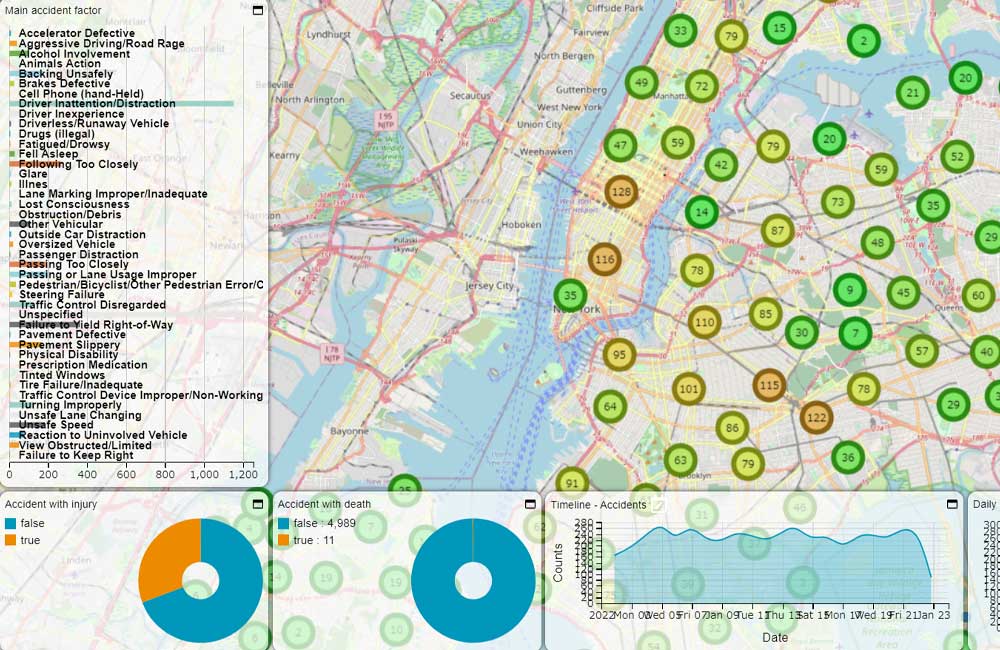Mapping out a safe and resilient society
Fujitsu / April 4, 2023
Fujitsu and Hexagon are working together to create powerful maps that help to enhance safety in society. Fujitsu’s expert in charge of planning a more trusted society explains how his team is striving to add even more value to the data.
2030 is the year the United Nations has set as the target for global stakeholders to achieve the seventeen Sustainable Development Goals (SDGs). With seven years to go, Fujitsu Limited is working towards a time when people and things will be more closely connected via data and networks. This was the driving force behind the collaboration Fujitsu initiated in 2022 with Hexagon, a globally leading company of digital reality solutions, giving us further insights into the use of data.
Our Digital Twin technology is proving to be one of the most effective tools to meet societal challenges head on. This technology creates a virtual duplication of a physical object or system. With the resulting replica, users can simulate all kinds of scenarios to tackle complex problems and analyze real-time data.
Through this collaboration, we have identified two use cases that show how Digital Twin technology can increase the value of data in real-life situations.
Data-driven prevention of traffic accidents
Fujitsu and Hexagon have been developing a solution that combines various traffic information related to accidents on one map.
For this solution we start by working with an insurance company to obtain details of accidents gathered from a dashboard camera to assess the damage. Our system analyzes the footage to determine how, when and where the accidents occurred and displays processed outputs on a map using Hexagon’s Geographic Information System (GIS)*.

The system analyzes footage from a dashboard camera.
A vehicle connected to a digital device can provide us with a long list of records about how a driver reacted behind the wheel. Based on that information, it is possible to pinpoint what type of accidents tend to occur at certain locations and identify high-risk areas. This kind of data-driven feedback provides concrete information on how to prevent future accidents.
Fujitsu encourages more organizations to take advantage of the various information included on one single map like this and strengthen safety measures. This solution is not only valuable for businesses that use cars or trucks as part of their operations, but could also be utilized by local governments to secure the safety of citizens in traffic, especially for example the safety of children in school zones.
* Geographic Information System (GIS): A computer system that analyzes and displays geographically referenced information.

Fujitsu/Hexagon solution showing detailed accident records on one map.
Preparing for natural disasters with real-time information
The other jointly developed Fujitsu/Hexagon solution enables early planning for flood damage mitigation measures by using weather data to map out high-risk locations.
The map on the left shows the normal state of a certain region. This information is valuable for officials planning prevention measures, such as making hazard maps or conducting drills.
Whereas the red areas on the map on the right show real-time disaster information, enabling officials to quickly comprehend the situation and take actions, such as evacuate citizens or optimize the route for vehicles carrying relief goods to the affected areas.

Maps showing a normal state (left) and the situation under a disaster (right)
Based on the use cases described above, the potential for this solution is apparent both in everyday life and in emergency situations. We have received feedback that the system could be too costly if it was only used in emergencies. This has motivated us to rethink the information we display during normal times and ensure that it is providing value regardless of the situation.
The data truly comes to life when connected across different industries. This is the key to maximizing the value of the statistics and finding new ways to combine them.
Towards a Trusted Society
Fujitsu is working towards the goal of a Trusted Society that is built on trustworthy data and technology.
We have researched cities around the world to determine key issues and focus areas:
1. Public services in which people can participate more proactively
2. Sustainable transportation for people and goods
3. A closed loop energy cycle to create a net-zero society
These challenges need to be addressed by society as a whole and Fujitsu believes that creating an ecosystem that connects people, data and technology across industries is the way forward.
We will remain committed to working with diverse sectors so that we can contribute to creating an environment-first, resilient, and sustainable society in which people can live in peace and prosperity.
Set your sights on building a prosperous, sustainable society
Trusted Society
Fujitsu introduced a key focus area called ‘Trusted Society’ as a part of its business brand, Fujitsu Uvance.
We aim to create an environment-first, resilient society in which people can live in peace and prosperity.

Related information
Editor's Picks





